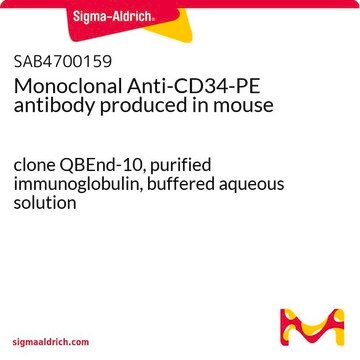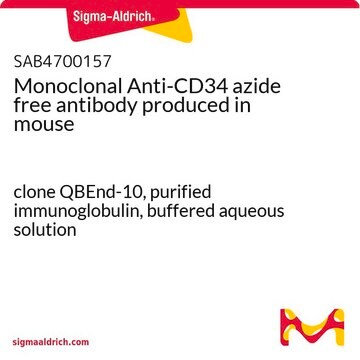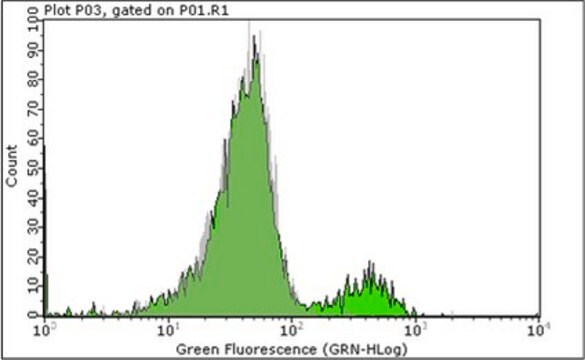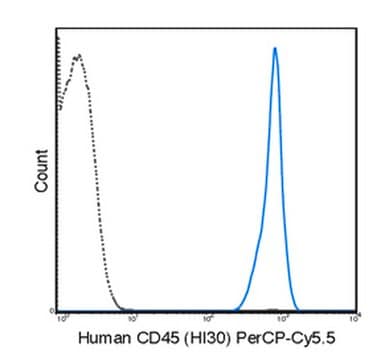CBL555
Anti-CD34 Class III Antibody, clone 581
clone 581, Chemicon®, from mouse
Sign Into View Organizational & Contract Pricing
All Photos(1)
About This Item
UNSPSC Code:
12352203
eCl@ss:
32160702
NACRES:
NA.41
Recommended Products
biological source
mouse
Quality Level
antibody form
affinity isolated antibody
antibody product type
primary antibodies
clone
581, monoclonal
species reactivity
human
manufacturer/tradename
Chemicon®
technique(s)
flow cytometry: suitable
isotype
IgG1
NCBI accession no.
UniProt accession no.
shipped in
wet ice
target post-translational modification
unmodified
Gene Information
human ... CD34(947)
Specificity
Clone 581 reacts with the class III CD34 epitope is resistant to neuraminidase, chymopapain and glycoprotease.
The antibody reacts with a single-chain 105-120 kDa heavily O-glycosylated transmembrane glycoprotein which is expressed on haematopoietic progenitor cells, vascular endothelium and some tissue fibroblasts. The intracellular chain of the CD34 antigen is a site of phosphorylation by activated protein kinase C suggesting a putative role in signal transduction. CD34 may also play a role in the adhesion of specific antigens to endothelium.
The antibody reacts with a single-chain 105-120 kDa heavily O-glycosylated transmembrane glycoprotein which is expressed on haematopoietic progenitor cells, vascular endothelium and some tissue fibroblasts. The intracellular chain of the CD34 antigen is a site of phosphorylation by activated protein kinase C suggesting a putative role in signal transduction. CD34 may also play a role in the adhesion of specific antigens to endothelium.
Application
Research Category
Inflammation & Immunology
Inflammation & Immunology
Research Sub Category
Immunoglobulins & Immunology
Immunoglobulins & Immunology
Study of the Class III CD34 epitope by FACS
Optimal working dilutions must be determined by the end user.
Optimal working dilutions must be determined by the end user.
This Anti-CD34 Antibody, Class III, clone 581 is validated for use in FC for the detection of CD34 Class III.
Physical form
Format: Purified
Protein G affinity chromatography. The monoclonal is presented at a concentration of 100μg/1ml in phosphate buffered saline containing 10mM sodium azide and 1mg/ml bovine serum albumin. We recommend that each laboratory determine an optimum working titre for use in its particular application.
Storage and Stability
For use within 1 month of purchase store at +4°C, for long term storage aliquot antibody into small volumes and store at -20°C.
Legal Information
CHEMICON is a registered trademark of Merck KGaA, Darmstadt, Germany
Disclaimer
Unless otherwise stated in our catalog or other company documentation accompanying the product(s), our products are intended for research use only and are not to be used for any other purpose, which includes but is not limited to, unauthorized commercial uses, in vitro diagnostic uses, ex vivo or in vivo therapeutic uses or any type of consumption or application to humans or animals.
Not finding the right product?
Try our Product Selector Tool.
Storage Class Code
12 - Non Combustible Liquids
WGK
WGK 2
Flash Point(F)
Not applicable
Flash Point(C)
Not applicable
Certificates of Analysis (COA)
Search for Certificates of Analysis (COA) by entering the products Lot/Batch Number. Lot and Batch Numbers can be found on a product’s label following the words ‘Lot’ or ‘Batch’.
Already Own This Product?
Find documentation for the products that you have recently purchased in the Document Library.
Teresa Massam-Wu et al.
Methods in molecular biology (Clifton, N.J.), 1722, 249-260 (2017-12-22)
We present a method to capture mesenchymal stromal cells (MSCs) by adhesion to extracellular matrix (ECM) molecules under flow conditions. The technique simulates a physiological system and exploits the natural biological interactions of cells, through integrin receptors, with their ECM.
Alkistis Kapelouzou et al.
Journal of vascular research, 54(3), 156-169 (2017-05-10)
Atherosclerosis is the major cause of cardiovascular disease; hypercholesterolemia is a major risk factor. We hypothesized that specific TLR members (TLR2, TLR3, TLR4, TLR8) may play a role in atherosclerosis progression and its accompanying inflammatory response. We determined the association
Mahmoud Yousefifard et al.
Journal of stem cells & regenerative medicine, 18(2), 53-63 (2023-01-31)
Few studies are conducted on the efficacy of human adipose-derived stem cells (ADSCs) in spinal cord injury (SCI) management and electrophysiological changes in the spinal cord. Therefore, the present study aimed to determine the effect of ADSCs on neuropathic pain
Our team of scientists has experience in all areas of research including Life Science, Material Science, Chemical Synthesis, Chromatography, Analytical and many others.
Contact Technical Service








